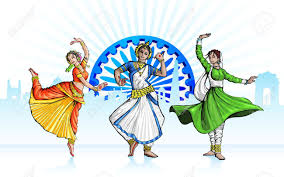Dance is a powerful impulse that is channeled by skillful performers into something that becomes intensely expressive. Dance as a powerful impulse and dance as a skillfully choreographed art practiced largely by a few are the two most important connecting ideas.
Dance is the movement of the body in a rhythmic way, usually to music, it emplifies the collaboration of choreographers and writers for the purpose of expressing. It reflects the creativity and emotion of the performers.
Performing arts like classical dances are integral parts of Indian culture. India is well known for its rich cultural legacy considered as the mother art of classical dances. The roots of dance is traced back from the Sanskrit text ‘Natya Shastra’. The first compilation of Natya Shastra is dated between 200BCE and 200CE. These incredible traditional dances of India were originated during the ancient times. The Classical Dances of India includes Bharatanatyam, which is the oldest and popular form of the classical dance in the country and ancient in Natya Shastra.
Indian classical dance was developed as a part of religious ritual in which dancers worshipped the gods by telling stories about their lives. Three main components form the basis of these dances. They are natya, the dramatic element of the dance (i.e., the imitation of character). Nritta, pure dance, in which the rhythms and phrases of the music are reflected in the decorative movements of the hands, body and in stamping of the feet; and Nritya, the portrayal of mood through facial expression, hand gesture, and position of the legs and feet.
The style of movement in Indian classical dance is very different from that of Western dance. In Indian dance; however, the legs are usually bent, with the feet flat rather than lifted and pointed. The stamping rhythms enhance the musicality of the dance; The torso, face, arms, and hands are extremely active. The head is quite mobile, with subtle changes of direction and a characteristic side-to-side movement emphasizing the dancer’s changing facial expressions. The movement of the torso is graceful and fluid every gesture having a narrative function. Indian dancers have a vast repertoire of gestures through which they express complex events, ideas, and emotions. There are, for example, 13 gestures of the head, 36 different glances, and 67 mudras or hand gestures in various combinations yield several thousand different meanings. These are the characteristics of Indian Dance.
India has thousands of years old tradition of fine arts and classical folk dances. Some of the world-famous dance forms that originated and evolved in India are:
Bharatanatyam, Kathak, Kathakali, Kuchipudi, Manipuri, Mohiniattam and Odissi.
Bharatanatyam
Bharatanatyam is one of the most popular classical Indian dances and it is more popular in South Indian states of Tamil Nadu and Karnataka. This Dance is almost 2,000 years old. It is believed that Bharatanatyam was revealed by Lord Brahma to Bharata, a famous sage who then coded this sacred dance in a Sanskrit text called the Natya Shastra. The Natya Shastra is one of the fundamental on Indian drama and aesthetics.
Kathak
Kathak is one of the most important classical dances of India. Kathak is said to be derived from the word katha, meaning "the art of storytelling." It originated in north India and was very similar to the Bharatanatyam dance form. In ancient India there were Kathakars or bards who used to recite religious and mythological tales to accompaniment music, mime and dance.
Kathakali
Kathakali is the classical dance form of Kerala. The word Kathakali literally means "Story-Play". Kathakali is known for its heavy, elaborate makeup and costumes. The colorful and fascinating costumes of Kathakali is the most recognized icon of Kerala. It is considered as one of the most magnificent theatres of imagination and creativity. This dance presents themes derived from the Ramayana, Mahabharata and other Hindu epics.
Kuchipudi
Kuchipudi is one of the classical dance forms of the South India. Kuchipudi derives its name from the Kuchipudi village of Andhra Pradesh. In the seventeenth century the Kuchipudi village was presented to the Brahmins who were experts in staging dance and drama. Kuchipudi exhibits scenes from the Hindu Epics, legends and mythological tales through a combination of music, dance and acting. Like other classical dances, it also comprises pure dance and mime. The use of speech distinguishes Kuchipudi's presentation as dance drama.
Manipuri
Manipuri is one of the six major classical dances of India. Manipuri dance is indigenous to Manipur, the North eastern state of India. The Manipuri dance style is inextricably woven into the life pattern of Manipuri people. The most striking part of Manipur dance is its colorful decoration, lightness of dancing foot, delicacy of abhinaya (drama), lilting music and poetic charm. The Manipuri dance form is mostly ritualistic and draws heavily from the rich culture of the state of manipur.
Mohiniattam
Mohiniattam is a classical dance form of Kerala. Mohiniattam is derived from the words "Mohini" (meaning beautiful women) and "attam"(meaning dance). Thus, Mohiniattam dance form is a beautiful feminine style with surging flow of body movements .
Odissi
Odissi is one of the famous classical Indian dances from Orissa state. The history of Odissi dance is almost two thousand years old. Odissi is an ecstatic and sensuous form of dance. The state of Orissa has a great cultural history.
Indian classical dances are very popular dance all over the world.

